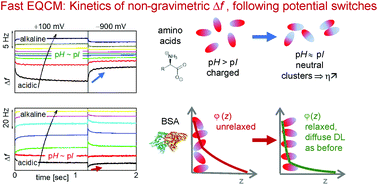Fast and slow EQCM response of zwitterionic weak electrolytes to changes in the electrode potential: a pH-mediated mechanism†
Abstract
Using a fast electrochemical quartz crystal microbalance (EQCM), zwitterionic electrolytes were studied with regard to changes of resonance frequency and resonance bandwidth after the electrode potential was switched. In addition to a fast change of frequency (within milliseconds), a further, slower process with opposite direction is observed. Both the fast and the slow process change sign when the pH is varied across the isoelectric point (pI). The fast process can be attributed to double layer recharging. Its characteristic time is slightly larger than the charge response time (the RC-time) as inferred from electrochemical impedance spectroscopy (EIS). With regard to the slow process, amino acids with moderate concentration behave markedly different from concentrated solutions of proteins. For amino acids, the slow process is larger in amplitude than the fast process and the QCM response is Sauerbrey-like. The shift in half bandwidth is smaller than the shift in frequency and the overtone-normalized frequency shifts agree between overtones (−Δf/n ≈ const. with n the overtone order). This can be explained with a viscosity change in the diffuse double layer. Independent measurements show that the viscosities of these electrolytes are higher than the average in a pH range around the pI. Presumably, the slow process reflects a rearrangement of molecules after the net charge on the molecule has increased or decreased, changing the degree of dipolar coupling and, in consequence, the viscosity. For concentrated solutions of bovine serum albumin (BSA), the QCM response does not follow Sauerbrey behaviour, which can be explained with viscoelasticity and viscoelastic dispersion. The slow process lets the frequency and the bandwidth relax towards a baseline, which is the same for jumps to more positive and to more negative potentials. Presumably, the slow process in this case is caused by a reorientation of molecules inside the Helmholtz layer, such that they screen the electric field more efficiently than immediately after the voltage jump.



 Please wait while we load your content...
Please wait while we load your content...